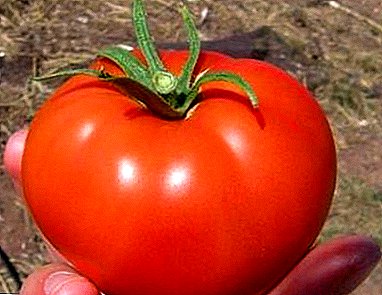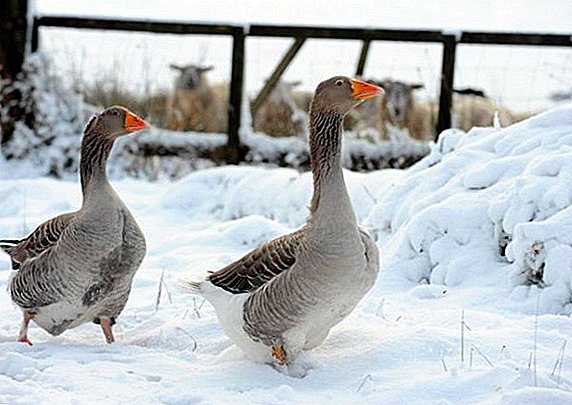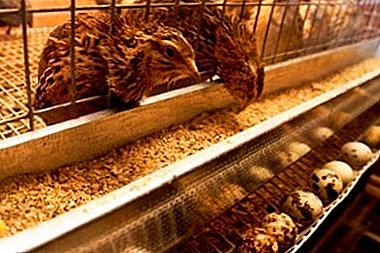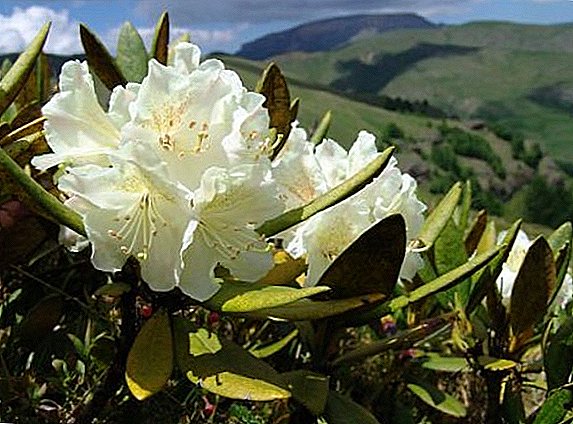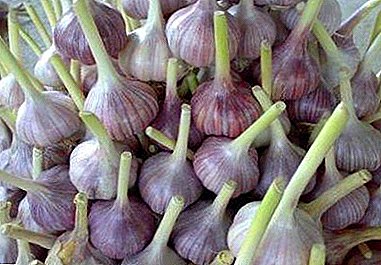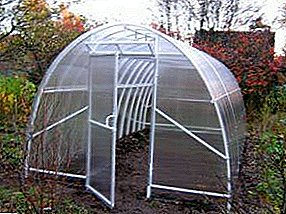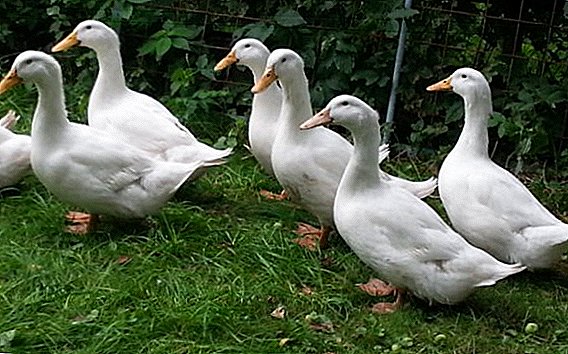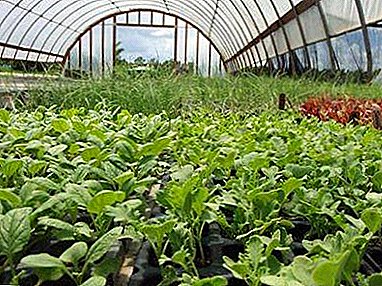 From year to year, many summer residents and gardeners are looking for new varieties of potatoes that could meet their ideal requirements: high yields, excellent taste, unpretentious care, fast growth and long shelf life. Potato variety "Krasa" satisfies almost every item listed above, therefore, we decided to tell you more about this wonderful variety of root vegetables.
From year to year, many summer residents and gardeners are looking for new varieties of potatoes that could meet their ideal requirements: high yields, excellent taste, unpretentious care, fast growth and long shelf life. Potato variety "Krasa" satisfies almost every item listed above, therefore, we decided to tell you more about this wonderful variety of root vegetables.
About variety selection
This potato variety was bred by the best European breeders. On the shelves of shops, "Krasa" appeared only in the 2000s, after which its popularity spread over many countries. Moreover, this variety is one of the few that has worked well on the terrible lands of Siberia.
In the CIS countries, the company "SeedEra" is involved in the distribution of "Krasa" potatoes, whose branches are located in some Ukrainian cities, as well as in the famous Chinese metropolis - Shanghai.
Did you know? The birthplace of potatoes is South America.
Botanical description
The general characteristics of the variety largely coincide with the botanical description of other plants of the genus Pasalin. 
Bushes
Shrubs are formed moderately sprawling, powerful, erect. The stem part is quite massive, due to the genetic component (fertilizer with nitrogenous components can lead to the fact that the bushes grow even more massive). On large farms, where the care of potatoes is automated and standardized, the length of the shoots can reach 70 cm.
You will probably be interested to read about the beneficial properties of potatoes and potato flowers.
Sheets are formed on the shoots opposite one another, have 3-7 lateral lobes, are painted in a characteristic dark green color. The fruit is multi-seeded, shaped like a small immature tomato. The flowers are collected in the form of a shield on the top of the shoots. 
Tubers
With proper care, about 6-8 root crops are formed in each bush. The total weight of tubers can reach 300-400 g. Tubers have an oblong oval structure, covered with thick dense skin. The color of the skin varies from light pink to raspberry red.
Tubers have a pleasant aromatic taste. High taste qualities allow using Krasa potatoes for various culinary purposes: frying, boiling, baking, stewing.
The flesh is dense, crunchy, has a light yellow shade. Starch content in tubers is 15-19%. Eyes slightly go deeper into the root, while they have a cream color. 
Some features of the variety
Breeders made sure that the new variety of root vegetables had surprisingly pleasant features, as well as innovative distinctive features.
Disease resistance
The company "SeedEra" declares that the potato "Krasa" has resistance to all viral and fungal diseases that can affect members of the genus Pasan. However, pests will have to fight on their own.
Against the Colorado potato beetle should be sprayed with chemicals (pesticides, insecticides).
To combat the Colorado potato beetle, insecticides such as Regent, Inta-vir, Prestige, Iskra Zolotaya, Corado, Aktara, Launch, Calypso, Karbofos, Commander, Tanrek, Nemabakt, Lightning.

Ripening and yield
These indicators will directly depend on the growing conditions, the climatic region and the proper care of the variety. "Beauty" is a medium early variety, and the first crop appears already in 80-100 days after planting. The average yield per hectare is 400-450 centners.
Medium early ripening is also characteristic of potato varieties like Adretta, Courage, Sante, Ilyinsky, Rodrigo, Colombo.
Recumbency
When storage conditions are met, the keeping quality of the variety is quite high. Root crops can be stored for about 6 months (in the cellar, at low temperatures and average humidity). Experts note that the storage capacity of the Krasa variety is 95%.
Landing rules
The yield of potatoes will depend on the correctness of planting. During the planting work, it is necessary to select the right soil, apply fertilizer, choose the optimal place and carefully prepare the site. 
Timing
To plant this variety of potatoes in open ground can be in the form of seedlings or tubers. Seeds for seedlings are sown in late March - early April. The seedling is kept in a warm room, subject to the necessary and optimal conditions for care.
Important! The biggest harvest of the variety "Krasa" will be on well-aerated soils with a large amount of potassium and nitrogen in the composition.
In the open ground "Beauty" planted in late April (southern regions) or early to mid-May. It is important to understand that at the time of landing, night frosts should completely disappear, and the average daily temperature should not fall below + 7 ° C (for example, during the day + 15 ° C, at night - + 4 ° C, average daily - + 9.5 ° C).  It is also necessary to take into account the state of warming up the soil layers. Experts note that the soil should be heated at least half a meter deep, and its average mass temperature should be higher by 7-10 ° С from zero.
It is also necessary to take into account the state of warming up the soil layers. Experts note that the soil should be heated at least half a meter deep, and its average mass temperature should be higher by 7-10 ° С from zero.
Choosing a place
For planting "Krasa", well aerated soils, through which oxygen can freely walk, are best suited. These included black soil, floodplain soils, peatlands, loamy and sandy soils. It is not recommended to plant potatoes in pits, holes or other indentations.
We advise you to read about what types of soil exist, as well as what it depends on and how to improve soil fertility.
The fact is that in such places moisture often stagnates, especially in spring. Too much moisture can lead to putrefactive processes in the tubers. In addition, it is important to track the level of groundwater occurrence. It is best when groundwater passes under the ground no closer than 100 cm from the soil surface.  Otherwise, the potatoes will have to be planted in the ridges at a height of 15-20 cm. Potato bushes like well-lit areas, but poorly tolerate gusty winds, especially the north.
Otherwise, the potatoes will have to be planted in the ridges at a height of 15-20 cm. Potato bushes like well-lit areas, but poorly tolerate gusty winds, especially the north.
Did you know? There is a variety of potatoes with blue skin and pulp (Linzer Blaue).
It is best to plant the "Beauty" on the southern or southeastern slopes, where from the northern and north-western sides high shrubs will be placed to protect the potatoes from the winds. As for the crop rotation of potatoes, it is quite difficult to follow the recommendations of scientists in the field of the agrarian industry.
Learn more about vegetable crop rotation.
Experts recommend changing the place of planting potatoes every 3-4 years, but sometimes it becomes impossible due to the fact that people have these areas are too limited. However, the fact remains, and try to follow the recommendations you need, especially since it will bring you good yields of root vegetables.  By the way, good forerunners of potatoes are:
By the way, good forerunners of potatoes are:
- salad;
- cucumbers;
- legumes;
- pumpkin;
- bow;
- radish.
It is important to note that when potato is planted at the same place for more than 5 years in a row, various microorganisms-pests of the root crop accumulate in the soil. It is because of this that from 30 to 70% of the crop is suffering.
Soil preparation

This stage is really important, and in the step-by-step instructions it looks like this:
- Preparing the soil to start in the fall. The plot chosen for planting is dug up, all weeds and excess garbage are removed.
- Complex mineral fertilizers are applied to the site with the obligatory presence of potassium, phosphorus and nitrogen in the composition of the compounds.
- It is also recommended to make organic fertilizers in the form of humus, rotted manure or peat.
- In the spring, the plot should be re-dug. Fertilizers do not need to be made (if you do not take into account the addition of minerals during planting of root crops).
Preparation of planting material
From the proper preparation of planting material will depend on the degree of germination of plantings. And no matter how you plant potatoes (seedlings or tubers).
Video: how to prepare potatoes for planting The step-by-step process of preparing potatoes for planting is as follows:
- 10 days before the beginning of the planting, the potatoes must be removed from the storage and put in a warm place.
- Sort the potatoes (select non-viable tubers and discard).
- To process the planting material with fungicides ("Alirin-B", "Binoram", "Albit").
- Treat the tubers with ash. This procedure allows you to protect the planting material from future diseases and pests, as well as to increase the starch content in the root crop.
- If planting will be carried out by a seedling method, the treatment of bushes with fungicides and ashes is also necessary.
Landing pattern
Pits for planting potatoes "Krasa" should be dug on the spade bayonet, this depth will be more than enough. Nitrophoska and / or 300 g of humus are brought to the bottom of the planting fossa.  Each hole with planting material should be watered with a liter of warm water. The distance between the landings in the row is 35-40 cm. The distance between the rows should be 60-70 cm.
Each hole with planting material should be watered with a liter of warm water. The distance between the landings in the row is 35-40 cm. The distance between the rows should be 60-70 cm.
How to care
It is important to note that if you planted seedlings in open ground, then at risk of returning night frosts, the plantation must be covered with spanbond or film. Shelter will protect the still weak plants from sudden changes in temperature. Sunny warm days shelter can be removed.
Watering
In regions with frequent precipitation (more than 400 mm per year, most of which occur in the summer season), irrigation is not necessary.
In regions with a dry hot summer, where rainfall in the form of rain may not be observed for weeks, irrigation of potato bushes should be done every 2 days. At the same time, it is necessary to pour out 2-3 liters of water under each bush. 
Top dressing
Fertilizers are applied twice during the entire growing season. The first feeding is carried out before flowering, the second - after its completion.
As fertilizer, you can use bird droppings, herbal extract (prepared on the basis of any types of weeds growing on the site), urea, complex mineral fertilizers. Immediately after dressing, bushes with root vegetables should be watered abundantly.
Weeding and loosening the soil
Weed weeds need as they grow. This procedure is important and should be carried out at least 3 times per season. The extra weeds at the site pull out all the nutrients from the soil, depleting it and causing damage to the roots.
Important! Sprouts in tubers must germinate vertically, otherwise the sunrises will be belated.

Loosening is carried out immediately after irrigation. If the soil is not loosened, then it will begin to thicken, aeration will significantly decrease, the roots will begin to fade without enough oxygen. Loosening should be superficial, since damage to the tubers is unacceptable.
Immediately after loosening the soil can be mulched leaves, straw, or a thin layer of peat. Mulch helps to retain moisture in the soil (important during dry periods of summer).
Hilling
Hilling should begin when the length of the shoots reaches 15 cm in height. The second hilling is carried out 3 weeks after the first. It is necessary to choose the right weather for such a procedure: comfortable warm air temperature, average humidity, no rain.
We recommend that you familiarize yourself with the rules of hilling potatoes.
 Hilling is best done in the morning or evening. For such procedures, you can use a walk-behind tractor, a disc hiller or a regular hoe.
Hilling is best done in the morning or evening. For such procedures, you can use a walk-behind tractor, a disc hiller or a regular hoe.
It will be useful for owners of motoblocks to read about how to spud potatoes with a motoblock, as well as how to make an excavator for potatoes from an old bicycle.
Preventive treatment
Potatoes "Krasa" at the genetic level is protected from various viral and fungal diseases. That is why preventive treatments can not be carried out. In extreme cases, you can use insecticides or fungicides. During the invasion of the Colorado potato beetle, shoots are treated with herbicides or pesticides.
Harvesting and storage
Harvesting starts at 85-100 days after planting. Often this is the beginning-middle of August. After harvesting, the tubers should be sorted: leave something for planting, discard something (rotten and damaged), the rest should be put off for storage.  To keep the potatoes longer, experts recommend processing it with a weak solution of copper sulfate. Store tubers should be in a cool, moderately wet, better - dry place.
To keep the potatoes longer, experts recommend processing it with a weak solution of copper sulfate. Store tubers should be in a cool, moderately wet, better - dry place.
For a long time, it is customary to store potatoes in wooden boxes in the cellar, where the air temperature varies from +2 to +4 ° С. It is important to understand that a higher temperature will cause tubers to sprout, a lower one will cause the potatoes to deteriorate.
Advantages and disadvantages
The advantages of the variety "Krasa":
- tolerates drought and minor mechanical damage without any problems;
- high and stable yield;
- good keeping quality;
- resistance to major varietal diseases;
- product appearance and taste at a high level;
- relatively large weight of tubers when ripe.

Gardeners and agronomists do not note the negative qualities of the potato "Krasa". Under the basic rules for care, 99% of summer residents are satisfied with the harvest.
Did you know? The first vegetable that was grown in space is potatoes. And this was done in 1995.
Finally, I would like to note that the potato variety Krasa is perfect for planting in any region of the CIS countries. A large list of advantages and lack of drawbacks makes this variety one of the most popular among domestic summer residents.


